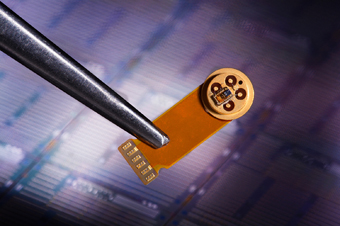Scientists Cross Photonic Hurdle to Faster Computer Chips
Scientists have made yet another big step toward replacing silicon chips with photonic circuits.
Research groups at the California Institute of Technology and the University of California, San Diego claim to have discovered a path to light signals on a silicon chip from reflecting backwards and interfering with its operation.
Transporting information in computer chips relies on a technique that allows current to flow in only one direction that avoids interference through a scattered beam that would make a signal and a chip unstable. So far, the model used in silicon chips, which relies on a diode to isolate electric signals, has not been possible. However the researchers say they have developed a metallic-silicon optical waveguide system to channel light so it travels in different patterns depending on its propagation direction. When traveling forward, the pattern is symmetric, but asymmetric when reflected backwards. According to a paper published in the journal Science, backscattered light is dissipated as a result.
"This discovery will help to realize a long-term goal of combining electronics with photonics to enable scalable, energy-efficient and cost-effective technology that will have a tremendous impact on such information systems as supercomputers, the Internet, and data centers," said Yeshaiahu Fainman, professor and chair of the UC San Diego Department of Electrical and Computer Engineering. "Computer technology will be able to handle a lot more data, faster and at lower cost, which will benefit large-scale business and government users as well as gadget-loving consumers."
Get Tom's Hardware's best news and in-depth reviews, straight to your inbox.

Douglas Perry was a freelance writer for Tom's Hardware covering semiconductors, storage technology, quantum computing, and processor power delivery. He has authored several books and is currently an editor for The Oregonian/OregonLive.
-
BluntObjection This just in, Breaking news!Reply
Folding@home cluster running on light cures death.
-
mister g I'll beleive it when I see it. There are so many technologies out there I doubt more than a few of them will make it into mass production. Still, I wish them the best of luck.Reply -
dread_cthulhu Can I haz? Once this is implemented... it sounds like computers really will be all smoke and mirrors!Reply -
dogman_1234 More tech to put into computers...pretty soon, computer will run on black holes with a single hydrogen atom processor. I will be dead when that happens though.Reply -
sseyler mister gI'll beleive it when I see it. There are so many technologies out there I doubt more than a few of them will make it into mass production. Still, I wish them the best of luck.Reply
This is still in the realm of applied physics, not "technology", so I'd hold your undue pessimism until later.
-
amigafan Yes I would like my motherboard to glow like commander Data's positronic brain when I open the case :)Reply -
11796pcs What's the difference between a circuit and a transistor? Are they the same because they sure sound like they are the same thing. Any clarification anyone?Reply
